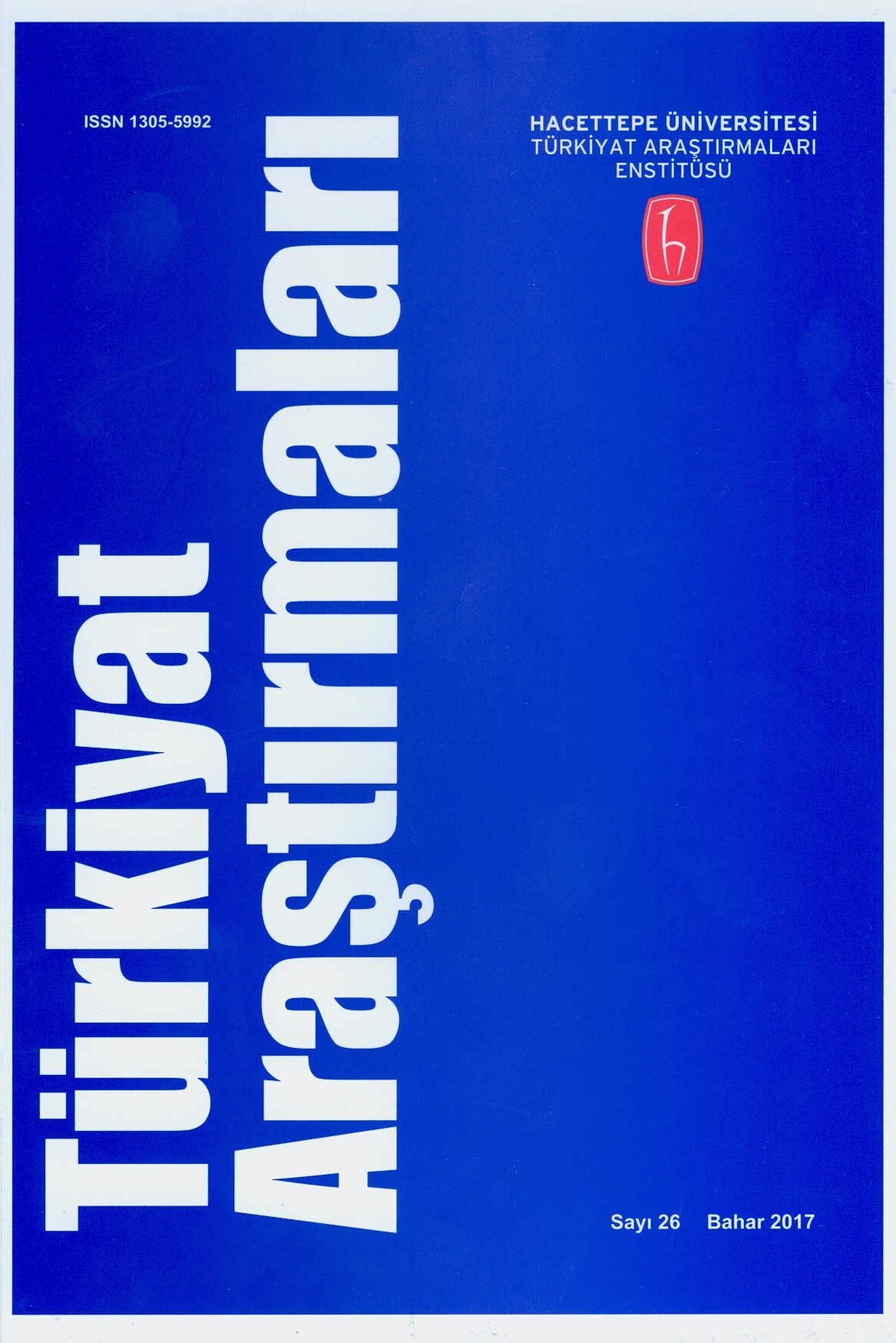Bibliothèque nationale de France’ta Muhafaza Edilen Sitātapatrādhāraṇī Fragmanları Üzerine
Eski Uygur edebiyatının büyük bölümünü Budist çevrede yazılmış olaneserler oluşturur. Bu eserler Uygurların çeviri edebiyatında geldikleri noktayıaçıklamak için önem teşkil eder. Tarihleri boyunca çeşitli dinlere mensup olanUygurların, genel olarak Mahāyāna Budizmi ve onun bir kolu olan Vajrayānayani Tibet Budizmini de benimsedikleri görülmektedir. Vajrayāna/ TibetBudizminin ise temeli çeşitli Tantrik metinler vasıtasıyla oluşturulmuştur. Bumakalede Uygurların çeviri edebiyatına ait Tantrik metinlerden birisi olanSitātapatrādhāraṇī (ārya sarva-tathāgata-uṣṇīṣa-sitātapatrā-aparājitā nāmadhāraṇī)hakkında bilgi verilerek Paris’teki Bibliothèque nationale de France’ta(BNF-Fransa Millî Kütüphanesi) muhafaza edilen 2 fragmanının katalog bilgileriile faksimileleri dâhilinde transkripsiyonu ve transliterasyonu yapılacaktır.
Anahtar Kelimeler:
Budizm, Eski Uygurca, Sitātapatrādhāraṇī, Vajrayāna, Bibliothèque nationale de France
___
- Arat, R. R. (1965). Eski Türk Şiiri. Ankara: Türk Tarih Kurumu Basımevi.
- Berthier, A. (2000). Manuscrits, xylographies, estampages: Les collections orientalesdu Départment des Manuscrits (Bibliothèque Nationale). Paris.
- Buswell, R. E. ve Lopez, D. S. (2013). The Princeton Dictionary of Buddhism.Princeton: Princeton University Press.
- Conze, E. (2008). Buddhism. A Short History. Oxford: Oneworld Publications.
- Edgerton, F. (1953). Buddhist Hybrid Sanskrit, Grammar and Dictionary, Vol. II:Dictionary. New Haven: Yale University Press.
- Elverskog, J. (1997). Uygur Buddhist Literature (Silk Road Studies I). Turhout, Brepols.
- Getty, A. (1914). The Gods of Northern Buddhism. Their Hsitory, Iconography andProgressive Evolution Through the Northern Buddhist Countries. Oxford:Clarendon Press.
- Knüppel, M. ve Yakup, A. (2007). Alttürkische Handschriften. Teil 11: Die uigurischenBlockdrucke der Berliner Turfansammlung. Teil 1: Tantrische Texte. Stuttgart:Franz Steiner Verlag.
- Küçük, A., Tümer, G. ve Küçük, M. A. (2011). Dinler Tarihi. Ankara: BerikanYayınevi.
- Le Coq, A. von. (1919). Kurze Einführung in die uigurische Schriftkunde. Mitteilungendes Seminars für Orientalische Sprachen an der F. Wilhelms-Universität zuBerlin 22 (2). 93-109.
- Ligeti, L. (1973). Le sacrifice offert aux ancestres dans l’Histoire secrète. ActaOrientalia Academiae Scientiarum Hungaricae 27 (2). 145-161.
- Malov, S. E. (1930). Sitātapatrā-dhāraṇī v ujgurskoj redakcii. Doklady Akademii NaukSSSR 5. 88-94.
- Monier-Williams, S. M. (1899). A Sanskrit–English Dictionary, Etymologically andPhilologically Arranged with Special Reference to Cognate Indo–EuropeanLanguages. Oxford.
- Moriyasu, T. (1985). Uiguru-go bunken [Uigurica from Tun-huang]. Kōza Tonkō VI:Tonkō Ko-go bunken [Lecture Series on Tun-huang VI: Literature in CentralAsian Languages from Tun-huang] (Z. Yamaguchi Ed.). Tokyo: Daitōshuppansha. 1–98. (森安孝夫「ウイグル語文獻」山口瑞鳳(編)『講座敦煌6 敦煌胡語文獻』東京:大東出版社,1985. 1–98).
- Müller, F.W.K. (1911). Uigurica II. Berlin: Verlag der Königlichen Akademie derWissenschaften.
- Pchelin, N. ve Raschmann, S. C. (2016). Turfan Manuscripts in the State Hermitage- arediscovery. Written Monuments of Orient 2 (4). 3-43.
- Porció, T. (1997). Preliminary Notes on the Uigur and Tibetan Versions of theSitātapatrādhāraṇī. Historical and Linguistic Interaction between Inner-Asiaand Europe (Proceedings of the Permanent International Altaistic Conference)(Á. Berta ve E. Horváth Ed.) içinde (229-241). Szeged: Department of AltaicStudies.
- Porció, T. (2000). The One with the White Parasol, Four Sitātapatrā Texts in the DergeKanjur and a Dunhuang Text (Pelliot Tibétain No. 45) with an AnnotatedEnglish Translation of the Longest Canonical Version. Yayımlanmamışdoktora tezi. Faculty of Arts of the University of Vienna. Vienna.
- Porció, T. (2003a). On the Technique Translating Buddhist Texts into Uygur. Indienund Zentralasien, Sprach und Kulturkontakt (Veröffentlichungen der SocietasUralo-Altaica 61) (S. Bretfeld ve J. Wilkens Ed.) içinde (85-94). Wiesbaden:Harrasowitz Verlag.
- Porció, T. (2003b). On the Brāhmī Glosses of the Uygur Sitātapatrā Text. CentralAsiatic Journal 47. 91-109.
- Powers, J. (2007). Introduction to Tibetan Buddhism. New York & Colorado: SnowLion Publications.
- Röhrborn, K. ve Róna-Tas, A. (2005). Spätformen des zentralasiatischen Buddhismus,Die altuigurische Sitātapatrā-dhāraṇī. Göttingen.
- Sarıkçıoğlu, E. (1983). Başlangıçtan Günümüze Dinler Tarihi. İstanbul: Otağ Yayınevi.
- Sárközi, A. (2007). Goddess with the White Parasol! Protect Us!. The Role of Women inthe Altaic World (Asiatische Forchungen 152). 231-246.
- Sengupta, S. (1999). A Note on Uṣṇīṣa Sitātapatrā Pratyaṁgirā ... Dhāraṇī. Studies inHindu and Buddhist Art (P. K. Mishra Ed.) içinde (49-56). New Delhi:Abhinav Publications.
- Shaw, M. E. (2006). Buddhist Goddess of India. Princeton: Princeton University Press.
- Shōgaito, M. (1979). A Study of the Fragments of Uygur Texts Found in the NakamuraFusetsu Collection (中村不折氏舊藏ウイグル語文書斷片の研究). TōyōGahukō 61 (1-2). 1-29.
- Silk, J. A. (1989). A Note on the Opening Formula of Buddhist Sūtras. The Journal ofthe International Association of Buddhist Studies, 12 (1), 158-163.
- Soothill, W. E. ve Lewis, H. (1937). A Dictionary of Chinese Buddhist Terms. London:Kegan Paul, Trench, Trubner & Co. Ltd.
- Taishō, (2016). 19.11.2016 tarihinde The SAT Daizōkyō Text Database genel ağsayfasından erişildi: http://21dzk.l.u-tokyo.ac.jp/SAT/satdb2015.php?lang=en
- Zieme, P. (1975). Zur buddhistischen Stabreimdichtung der alten Uiguren. ActaOrientalia Academiae Scientiarum Hungaricae, 29 (2), 187-211.
- Zieme, P. (1982). Zum uigurischen Tārā-Ekaviṃśatistotra. Acta Orientalia AcademiaeScientiarum Hungaricae 36 (1-3). 583-597.
- Zieme, P. (1985). Buddhistische Stabreimdichtungen der Uiguren. BT XIII. Berlin:Akademie Verlag.
- Zieme, P. (2014). Neues zur altuigurischen Sitātapatrādhāraṇī. 21.11.2016 tarihindeacademia.edu genel ağ adresinden erişildi:https://www.academia.edu/9184825/Neues_zur_altuigurischen_Sit%C4%81tapatr%C4%81dh%C4%81ra%E1%B9%87%C4%AB
- ISSN: 1305-5992
- Yayın Aralığı: Yılda 2 Sayı
- Başlangıç: 2004
- Yayıncı: Hacettepe Üniversitesi
Sayıdaki Diğer Makaleler
Teleütçenin Tehlikedeki Dil Araştırmalarındaki Yeri
Almanya ve Avusturya’da Dördüncü Kuşak Türk Gençleri
Macaristan’da Son Osmanlı Garnizonu: Temeşvar’a “Eğri Nizamı”nın Verilmesi ve Maliyeti
Dilbilgiselleşme ve Edat Kavramı
Kısas-ı Enbiya’da “Gönül” Sözcüğüyle Kurulan Deyimlerin Organ Adları Temelinde Çağrışımsal Anlamı
Bibliothèque nationale de France’ta Muhafaza Edilen Sitātapatrādhāraṇī Fragmanları Üzerine
İslam Devrimi’nden Sonra Türk Edebiyatından Yapılan Tercümelerin İran’daki Yeri
